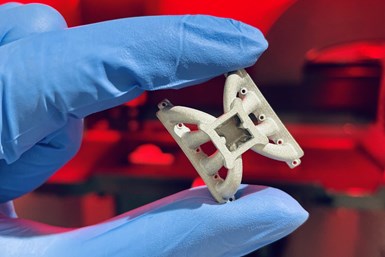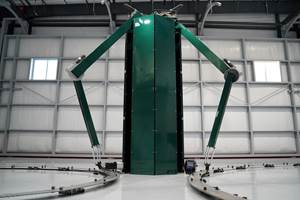Incus Successfully Tests Lithography-Based Metal Manufacturing for Lunar Environment
The project aim was to develop a sustainable process that uses lunar resources and recycled scrap metals (eventually contaminated by lunar dust) to produce spare parts on-site which could help and enhance human settlement on the moon.
Incus, a provider of lithography-based solutions for additive manufacturing (AM), has successfully completed its joint 18-month project with the European Space Agency (ESA), OHB System AG and Lithoz GmbH to test the potential of 3D printing and zero-waste workflow for the lunar environment. The ESA-sponsored project, developed by Incus and Lithoz GmbH under the coordination of OHB System AG as prime contractor, aimed to research the feasibility of processing lunar scrap metals (which might be recovered from debris from old missions or old satellites) to produce high-quality printed parts using AM, specifically lithography-based metal manufacturing, also taking into consideration potential in situ contamination by using lunar regolith simulant.
The project’s goal was to develop a sustainable process that uses lunar resources and recycled scrap metals, eventually contaminated by lunar dust, to produce spare parts on-site which could help and enhance human settlement on the Moon. The successful use of lunar resources and recycling of scrap metals is vital to the creation of a sustainable Moon base. Lithography-based metal manufacturing (LMM) was selected for its ability to print from recycled metal waste and its ease and safety during printing and postprocessing.
The biggest challenge for lunar AM is the harsh lunar environment, including the atmosphere, gravity, temperature, radiation and the potential contamination of moon dust. However, the Hammer Lab35 Incus 3D printing solution was able to print recycled titanium powder while maintaining proper part quality. The produced parts demonstrated a high level of strength, comparable to Metal Injection Molded Titanium parts standards (1,000-1,050 MPa).
The LMM technology used in the project can print from scrap metals using premixed feedstock, without free and loose powder and the need for any support structures, offering a sustainable zero-waste workflow. The project also included the development of a green binder and the optimization of preprocessing and postprocessing steps to print and test different demonstrators for future lunar applications.
The project's results have important implications for the future of space exploration and the development of sustainable Moon bases. “This project has proven that LMM technology is able to use recycled powder for the feedstock material and provide sustainable zero-waste workflow,” says Dr. Gerald Mitteramskogler, Incus CEO. “We expect that further developments in metal recycling technologies will open the way to metal materials with more settled sintering processes for the lunar environment.”
The project’s optimal scenario for the 3D printing habitat on the Moon base is comparable to that on Earth, with reduced gravity and human-graded radiation shielding, ensuring that no major modifications or redesigns are required aside from the size, mass and volume reduction of the 3D printer. “Considering the challenge of bringing humans back to the Moon and building a base, the topic of in-situ resource utilization (ISRU) is gaining significant momentum. Projects like this, recently completed by Incus and project partners, demonstrate that manufacturing methods like LMM are very good candidates to support such an endeavour,” says Dr. Martina Meisnar, materials and processes engineer at ESA.
According to Dr. Martin Schwentenwein, head of material development at Lithoz, this successful collaboration showed that lithography-based AM techniques are among the most promising candidates to let 3D printing in space become a reality in the future.
The use of local lunar resources, as well as the recycling of old spacecraft, are essential for a sustainable and Earth-independent Moon base. “Through this project, it was proven that the LMM technology is able to use recycled powder sources as feedstock material. Furthermore, it was demonstrated that contaminations for the powder sources by using lunar regolith simulant are manageable, especially from the perspective of the printing process,” says Francesco Caltavituro, OHB system engineer for the project. “With those aspects in mind, as well as the future challenges already foreseen and anticipated, upcoming research and development will be able to continue and open up further the way toward a sustainable Moon settlement finally released from Earth dependency.”
- Read more about the Incus project to test 3D printing spare parts in space. The project goal was to assess the feasibility of processing scrap metals available on the moon’s surface to produce a high-quality final product via a zero-waste process.
- Here are more details about stereolithography for metals producing detailed parts. Lithography-based metal manufacturing (LMM) is a technique developed by Incus using a curing process based on stereolithography to build green metal parts with photopolymer.
Related Content
3D Printed Titanium Replaces Aluminum for Unmanned Aircraft Wing Splice: The Cool Parts Show #72
Rapid Plasma Deposition produces the near-net-shape preform for a newly designed wing splice for remotely piloted aircraft from General Atomics. The Cool Parts Show visits Norsk Titanium, where this part is made.
Read More“Mantis” AM System for Spacecraft Uses Induction for Deposition
The metal 3D printing system melts wire without lasers. 30-foot-diameter parts are built on a rotary-feed system that eliminates the need for a large machine frame or gantry.
Read MoreVideo: For 3D Printed Aircraft Structure, Machining Aids Fatigue Strength
Machining is a valuable complement to directed energy deposition, says Big Metal Additive. Topology-optimized aircraft parts illustrate the improvement in part performance from machining as the part is being built.
Read More3D Printed NASA Thrust Chamber Assembly Combines Two Metal Processes: The Cool Parts Show #71
Laser powder bed fusion and directed energy deposition combine for an integrated multimetal rocket propulsion system that will save cost and time for NASA. The Cool Parts Show visits NASA’s Marshall Space Flight Center.
Read MoreRead Next
Alquist 3D Looks Toward a Carbon-Sequestering Future with 3D Printed Infrastructure
The Colorado startup aims to reduce the carbon footprint of new buildings, homes and city infrastructure with robotic 3D printing and a specialized geopolymer material.
Read MorePostprocessing Steps and Costs for Metal 3D Printing
When your metal part is done 3D printing, you just pull it out of the machine and start using it, right? Not exactly.
Read MoreProfilometry-Based Indentation Plastometry (PIP) as an Alternative to Standard Tensile Testing
UK-based Plastometrex offers a benchtop testing device utilizing PIP to quickly and easily analyze the yield strength, tensile strength and uniform elongation of samples and even printed parts. The solution is particularly useful for additive manufacturing.
Read More






















